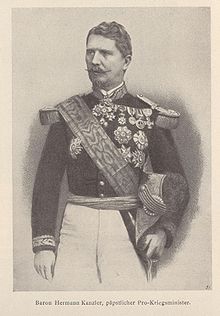Hermann Chancellor
Hermann Chancellor (* 28. March 1822 in Weingarten , † 6. January 1888 in Rome ) was papal general, pro-Minister of weapons and Supreme Commander of the Pontifical army in the Papal States . He was ennobled as a baron by the Chancellor.
Life
Career in Germany
Hermann Kanzler was born in Weingarten near Karlsruhe in 1822 as the son of the tax perequator Max Anton Kanzler. The family later moved to Bruchsal , where the boy grew up. He served with the Dragoons in Karlsruhe. According to local tradition, his Rittmeister resigned - angry about the anti-church attitude of the Baden government - and joined the papal army. In doing so, he persuaded his fellow, the Corporal Chancellor, to go to Rome with him and also become a papal soldier. In December 1843, Hermann Kanzler took leave of the Grand Ducal Baden military.
In papal service
Hermann Kanzler entered the papal army service in 1845, fought against Austria in 1848, was appointed Colonel of the 1st Regiment of the Papal Army in 1859 and promoted to General by Commander-in-Chief Lamoricière in 1860 as an award for his daring breakthrough from Pesaro to Ancona through the Piedmontese corps. Since October 1865 he was commander-in-chief of the papal armed forces and papal prominister of arms. He commanded the papal troops in their victory on November 3, 1867 in the Battle of Mentana over the numerically inferior Garibaldi troops (4,700 Garibaldi volunteers against about 12,000 soldiers on the papal French side). He later led the mock defense of Rome in September 1870, in which Pope Pius IX. to demonstrate to the world his inalienable rights as head of state, but at the same time wanted to avoid shedding blood as much as possible. The papal army therefore offered only symbolic resistance. When the first breach in the wall at Porta Pia was shot on September 20, the fight was immediately stopped on the orders of the Pope to his Commander-in-Chief Hermann Kanzler.
The papal state had ceased to exist after more than 1000 years and the Pope no longer had any actual state territory. He considered himself - while nominally safeguarding his rights - as a "prisoner in the Vatican". Italy respected the Vatican City with the Pope as quasi extraterritorial without the legal status being formally clarified. Therefore, General Hermann Chancellor remained in the Vatican until his death on January 6, 1888 and nominally continued his office as prominister of arms and commander in chief of the papal troops; Due to the lack of state sovereignty, however, it was only symbolic. It was not until 1929 that the dispute between the Holy See and Italy was settled. The Pope renounced the historical rights to the Papal States and Italy recognized the Vatican City as a sovereign miniature state.
Hermann Kanzler carried the papal nobility title of Baron von Kanzler. His wife came from the ancient Roman count family Vannutelli , from which two cardinals also emerged. For a long time he sat on the board of directors of Campo Santo Teutonico and was friends with its director Anton de Waal . Hermann Kanzler's son Baron Rudolf Kanzler (born May 7, 1864) was a Vatican archaeologist and since 1896 a member of the Pontifical Commission for Christian Archeology . He was considered to be "the most competent expert on the topography of ancient Rome" and was a leader in excavations under St. Peter's Basilica and in the catacombs.
literature
- Meyers Großes Konversations-Lexikon , 1908 edition, p. 583.
- Andreas Niedermayer : The fighters for the Apostolic See in 1867 . Verlag für Kunst und Wissenschaft, Frankfurt am Main 1867, p. 7.
- Klemens August Eickholt: Rome's last days under the tiara - memories of a Roman gunner . Herder Verlag, Freiburg 1917, p. 20 and in several other places (Klemens August Eickholt was a retired papal officer).
- Julius Dorneich: Franz Josef Buss and the Catholic Movement in Baden . Herder Verlag, Freiburg 1979, p. 349.
- Karl-Heinz Lutz: The Baden officer corps 1840-1870 / 71 . Kohlhammer Verlag, Stuttgart 1997, p. 204.
- The Catholic Church of our time and its servants in words and images , Volume 1. Allgemeine Verlagsgesellschaft, Berlin 1899, pp. 142, 579 and 671.
Individual evidence
- ^ Albrecht Weiland: The Campo Santo Teutonico in Rome and its grave monuments (= The Campo Santo Teutonico in Rome , edited by Erwin Gatz , Volume 1). Herder, Freiburg im Breisgau 1988, ISBN 3-451-20882-2 , p. 381 f.
| personal data | |
|---|---|
| SURNAME | Chancellor, Hermann |
| BRIEF DESCRIPTION | papal minister, general and commander in chief of the troops Zuave |
| DATE OF BIRTH | March 28, 1822 |
| PLACE OF BIRTH | Weingarten (Baden) , |
| DATE OF DEATH | January 6, 1888 |
| Place of death | Rome |
